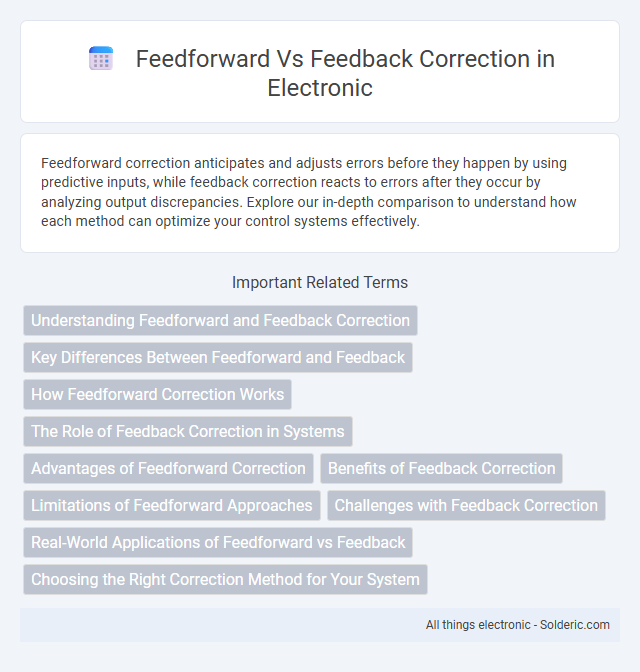Feedforward correction anticipates and adjusts errors before they happen by using predictive inputs, while feedback correction reacts to errors after they occur by analyzing output discrepancies. Explore our in-depth comparison to understand how each method can optimize your control systems effectively.
Comparison Table
| Aspect | Feedforward Correction | Feedback Correction |
|---|---|---|
| Definition | Predicts and adjusts errors before they occur using input data. | Detects and corrects errors after they occur using output data. |
| Response Time | Fast, proactive adjustment. | Slower, reactive adjustment. |
| Dependence | Relies on a model of the system and input signals. | Relies on measurement of output signals. |
| Accuracy | Depends on the accuracy of the predictive model. | Improves accuracy by correcting actual errors. |
| Stability | Generally stable, as it does not form loops. | Can introduce oscillations if not properly tuned. |
| Application | Useful in predictable systems with known disturbances. | Suitable for systems with unpredictable disturbances. |
| Example | Pre-adjusting motor speed based on load estimation. | Adjusting thermostat based on room temperature feedback. |
Understanding Feedforward and Feedback Correction
Feedforward correction anticipates errors by adjusting inputs based on predictive models, enhancing system performance before deviations occur. Feedback correction relies on monitoring outputs and correcting errors after they happen, ensuring accuracy through real-time response. Combining feedforward and feedback mechanisms optimizes control systems by balancing prediction and adjustment for stability and precision.
Key Differences Between Feedforward and Feedback
Feedforward correction anticipates errors by adjusting system inputs based on a model or prediction before the output occurs, while feedback correction responds to errors after detection by comparing actual output to a desired reference and making necessary adjustments. Feedforward operates preemptively without relying on error signals from the output, whereas feedback continuously monitors output performance to correct deviations. You can optimize system control by combining feedforward's predictive adjustments with feedback's real-time error corrections for enhanced accuracy and stability.
How Feedforward Correction Works
Feedforward correction anticipates errors by using predictive models based on input data and system behavior, allowing adjustments before deviations occur. This proactive approach minimizes response time and enhances system stability by modifying control signals in real-time without waiting for output errors. Your system benefits from improved accuracy and efficiency as feedforward correction reduces reliance on reactive feedback loops.
The Role of Feedback Correction in Systems
Feedback correction plays a crucial role in maintaining system stability and accuracy by continuously monitoring output and making real-time adjustments to reduce errors. It enables dynamic response to disturbances and uncertainties, ensuring consistent performance in complex control environments. This process enhances system reliability by correcting deviations from desired outcomes through closed-loop control mechanisms.
Advantages of Feedforward Correction
Feedforward correction offers the advantage of proactively addressing errors before they affect system performance, leading to improved stability and reduced response time. This method relies on prediction models, allowing your system to adapt quickly to disturbances without waiting for error detection. As a result, feedforward correction enhances precision and efficiency in control processes, especially in dynamic environments.
Benefits of Feedback Correction
Feedback correction enhances system accuracy by continuously monitoring output and making real-time adjustments to reduce errors. It improves stability and adaptability, allowing your control systems to respond effectively to unexpected disturbances or changes in the environment. This dynamic correction mechanism ensures reliable performance and consistent quality in various applications, from industrial automation to robotics.
Limitations of Feedforward Approaches
Feedforward control systems struggle with inaccuracies due to model uncertainties and external disturbances, as they rely solely on predefined system behavior without real-time error correction. These limitations make feedforward approaches less effective when unexpected variations occur, leading to potential deviations from desired performance. Incorporating feedback mechanisms helps address these challenges by continuously adjusting inputs based on observed output errors, enhancing overall system robustness.
Challenges with Feedback Correction
Feedback correction often faces challenges such as time delays and instability due to the system's reactive nature, which can lead to oscillations or overcorrection. Noise in measurement data further complicates precise error detection, reducing the effectiveness of corrective actions. Your control system may struggle to maintain optimal performance under rapid disturbances when relying solely on feedback correction.
Real-World Applications of Feedforward vs Feedback
Feedforward correction is widely used in robotics and industrial automation to anticipate and adjust actions before errors occur, enhancing system efficiency and precision. Feedback correction is essential in control systems like thermostats and autopilots, continuously monitoring output to correct deviations in real-time. Your choice between feedforward and feedback depends on the application's need for predictive adjustments versus reactive corrections.
Choosing the Right Correction Method for Your System
Selecting the right correction method for your system depends on the specific dynamics and response characteristics involved. Feedforward correction anticipates disturbances and applies proactive adjustments, making it ideal for systems with predictable inputs and fast response requirements. Feedback correction continuously monitors output errors and adjusts accordingly, providing robust performance in unpredictable environments or when system parameters vary.
Feedforward vs Feedback correction Infographic

 solderic.com
solderic.com